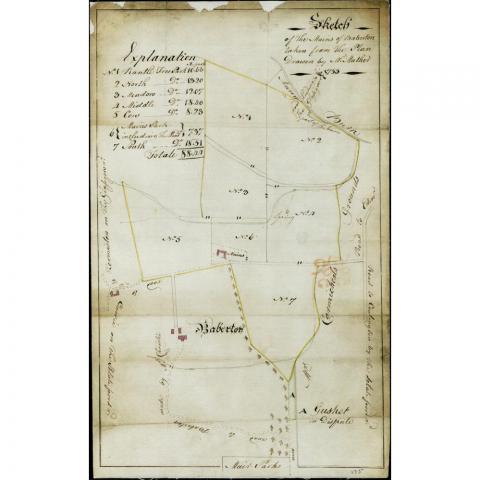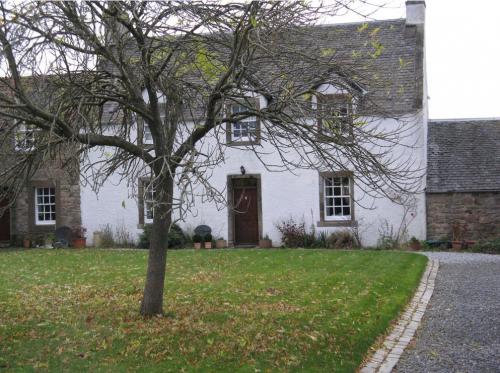Owners of the Farm
Baberton Mains Farm was the farm for the Baberton Estate, which was centred on Baberton House. The early history of Baberton House has already been covered under Kilbaberton, on this site, but is briefly summarised here as if reflects the ownership of the farm as well. The first owner of the estate was Hugh Taylor, mentioned in a charter in 1320. Between then and 1492 there were three other recorded owners –Thomas Eschington, William de Crafurde and the Forrester family of Corstorphine. From 1492 to 1612 the estate was owned by the Wardlaw family, except for a brief period when it was owned by John Elphinstone.
In 1612 the estate passed to Sir James Murray, Master of Works to the King, and a few years later, in 1625, he also acquired Wester Hailes. The Baberton Estate then followed a similar path to Wester Hailes, passing through the hands of the Brand family, until in 1699 it was sold to Mr John Fairholme, an advocate, for £18,338 Scots money, when Alexander Brand got into financial difficulties. This was slightly less than the £21,000 Scots that was paid for Wester Hailes Estate at the same time.
 |
| Plan of Baberton Mains 1756. Reproduced courtesy of National Records of Scotland, RHP595 |
Unfortunately, John Fairholme also got into severe financial difficulties. To avoid the debtors’ prison, he sought sanctuary at Holyrood Abbey in 1729. He owed £16,652 Scots money to Charles Inglis, just one of his many creditors, who was also an advocate and Clerk of the Bills for the Court of Session. After a complicated series of court cases, Charles ended up owning the Baberton Estate. After passing to his son, also named Charles, the estate was sold to the Christie family in 1749.
As with Wester Hailes, Baberton was surveyed by David Mather in 1755 and a plan produced. This shows a more organised estate compared to the Wester Hailes plan.
The colourful Christie family owned Baberton Estate until 1882 when it was sold to Sir James Gibson-Craig of Riccarton. It remained in the Gibson-Craig family for several generations, the final family member being Antonia Josephine Sudlow. She sold Baberton Mains Farm to Robert Eaglesham who was the tenant at the time. There was one more owner, James Young, from 1972 until 1975, when he sold part of the farmland to George Wimpey for housing.
Tenants of the Farm
The earliest tenants of Baberton Mains were named in a legal document of the Christie family in 1790 as Edward Yorston followed by John Smith. Exactly when they were tenants is unknown. Another legal document from 1819 notes that Walter Davidson was the tenant. Alexander Patullo, aged 40, was the tenant at the time of the first full census in 1841 and then it passed to the Scott family in 1842.
Like William Lawrie, the tenant at Fernieflat Farm in the 1840s, the Scott family of Baberton Mains Farm also got into financial problems. This time it was at the instigation of Archibald Christie who, between 1845 and 1850, tried to have William Scott and then his brother Robert Scott declared bankrupt. The court papers show that William Scott took over the lease of Baberton Mains Farm and Whitelaw Farm in 1842 at which point he found the lands had been greatly mismanaged and were run out of proper cultivation and the farm steadings were in a state of greatest disrepair and in many aspects of dilapidation. William spent large amounts of money on repairs and drainage of the two farms and fell behind in payment of the rent. He died in 1847 and his brother, Robert, planned to take over the lease. However, according to the lawyers for the Scott family, Archibald Christie used every means in their power to prevent this, and have run round the whole circle of schemes to oust the Respondent from the farm.
 |
| Whitehouse Baberton Mains Farmhouse |
Archibald wanted to bring in his own managers of the two farms. The Sheriff found in favour of the Scott family, but not before the death of Robert in 1850. Tenancy of Baberton Mains then passed to Robert’s brother, Gavin Scott. The Scott family’s problems did not stop there. As reported in The Scotsman on 3rd March 1852, Gavin Scott was seriously injured by being hit by a train: ACCIDENT – On Wednesday forenoon, Mr Gavin Scott, farmer, Baberton Mains, while incautiously walking along the line of the Caledonian Railway, between Whitelaw and Baberton, was suddenly overtaken by a pilot-engine, which, before he could get out of its way, violently threw him down upon the rails. The consequence was that his skull was almost scalped, his right arm broken, and several of his teeth knocked out.
Gavin survived, but moved into Edinburgh soon after this. The Atkinson family then briefly held the tenancy, followed by Robert Harper and then William Harper between 1865 and 1875. The farm was then tenanted by the Meikle family until the 1920s –they also leased Fernieflat Farm.
A detailed description of the farm buildings from this period has survived. The farmhouse, which was the new one built in 1890, was two-storeys, built of stone and lime and with a slate roof. Inside were a kitchen, scullery, parlour, drawing room, 4 bedrooms and pantry. There was also a dairy, henhouse and boilerhouse. The farm buildings consisted of three stables with 2 or 3 stalls, and one stable with 6 stalls and a box. There was also a meal shed, gig house, draff house (used in brewing), byre with 42 stalls, straw barn, straw house, granary and engine shed.
From 1920 until the 1940s the farm was leased by R and John J. Anderson and then by Robert Eaglesham, who became the owner in 1956.
When parts of Fernieflat Farm and Baberton Mains Farm were sold in the 1970s for housing it marked the end of farming on the land that had gone on for hundreds of years.